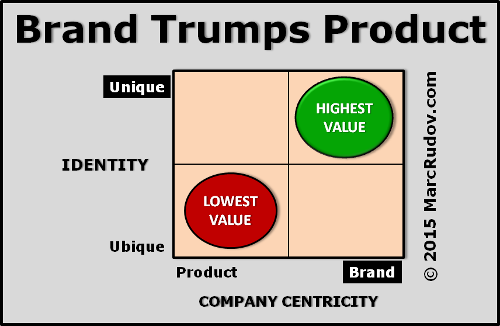 Silicon Valley is a high-octane, product-centric jungle, where branding (yuck!) is viewed with skepticism and derision. After all, this strip of Northern California isn’t called Solution Valley, is it?
Silicon Valley is a high-octane, product-centric jungle, where branding (yuck!) is viewed with skepticism and derision. After all, this strip of Northern California isn’t called Solution Valley, is it?
Newsflash: people buy solutions (value), not products. Moreover, products, like snowflakes, are ephemeral: they have fleeting, finite lifespans. Strong brands endure and outlive endless tech trends.
Don’t tell this, though, to the huge ecosystem of venture capitalists, evangelists, and incubators — they worship technologies and products, and don’t want to hear it.
Unfortunate consequence: almost every entrepreneur races to build the best product, sans brand, then struggles to explain its utility and unique value. Shouldn’t be a struggle. That’s why the horse (brand) goes before the (product) cart.
Demand the Brand
I’ll repeat what I wrote above and in Be Unique or Be Ignored: The CEO’s Guide to Branding: people buy solutions (value), not products.
A product is a means to an end, not the end. If you view “product as end,” you’re the CEO of an expensive hobby enterprise.
Not to worry. When, as in Silicon Valley, the universe of inventors is large enough, the flow of investment capital irrational enough, and the biased media hype loud enough, there will be hits — and there have been hits. At what cost?
Analogy: In 2013, the Yankees paid Alex Rodriguez $29M for hits; his batting average was a terrible .244. Getting the picture?
Any environment infused with technologica erotica will be, by definition, a highly inefficient, ineffective way to produce hits. If you’re an investor in such an obsessive environment, do your homework: demand the brand.
Neither Arrowhead nor Bow nor Archer
Every patent is, theoretically, a unique product or would-be product. Each one, therefore, a smashing commercial success, right? Wrong. According to a 2014 article in Forbes magazine:
| Of today’s 2.1M active patents, 95 percent fail to be licensed or commercialized. These unlicensed patents include over 50K high-quality patented inventions developed by universities. More than $5T has been spent in the US alone on research and development over the past 20 years, much of which went to create the very patents that remain unlicensed. According to Forrester Research, “US firms annually waste $1T in underused intellectual property assets by failing to extract the full value of that property through partnerships.” In other words, we’re pouring money — and productivity — down the drain. |
A product, a great product, a unique product is meaningless unless customers — potential and actual — value it. How do they come to value it? Skillful branding — begun before the product is built or conceived. I’ll repeat that: begun before the product is built or conceived.
Without a strong brand (people react to it, remember it, and repeat it — and they open their wallets because of it), a product is an arrow with neither arrowhead nor bow nor archer.
Lifestyle-Changer/Enhancer
Tim Cook is preparing for the upcoming launch of the Apple Watch — not as a product but as a lifestyle-changer/enhancer. That’s the brand! Never forget: a product is a means to an end. I predict that many customers will purchase the Apple Watch just for the bragging rights.
The figure below depicts the relationship between product and brand. A brandless product is truly limited in value. So, to yield the highest value, the CEO must create a brand-centric company; the brand must be unique. If you’ve read my book, you already know that neither a product name nor a logo is a brand.
The inverse is also true: To yield the lowest value, the CEO must create a product-centric, brandless company; the product must be ubique (common, generic). Note: companies that spew industry jargon are brandless.
Parting Advice for CEOs
If you’re running a product-centric company, you are self-relegated to selling commodities or struggling to peddle complex snowflakes with exorbitantly high costs of sales, capital, and media — and short lifespans.
Branding, as I’ve been telling you ad nauseam, is your #1 priority. Reject that advice at your peril and your shareholders’ peril.
Converting your company into a brand-centric enterprise requires major cultural, structural, and personnel changes. Make them. Brand trumps product, and success trumps failure.
POSTSCRIPT #1: Mark Cuban: We’re In a Tech Bubble — It’s Worse Than 2000
POSTSCRIPT #2: Startup Valuations Are Based on Alchemy and Dealmaking — Not Value
POSTSCRIPT #3: Stewart Butterfield of Slack: There’s No Logic to Valuations
POSTSCRIPT #4: Biased Media Hype — and Lack of Unique Brand — Caused Meerkat’s Short-Lived Fame
POSTSCRIPT #5: What the Apple Watch Does Best: Make You Look Good
POSTSCRIPT #6: Michael Kors Learns That Fad-Hopping Isn’t Branding
POSTSCRIPT #7: DANGER: Potential Merger of Dell and EMC About Tech, NOT Brand
© 2015 Marc H. Rudov. All Rights Reserved.
About the Author

Marc Rudov is a branding advisor to CEOs,
producer of MarcRudovTV, and author of four books


